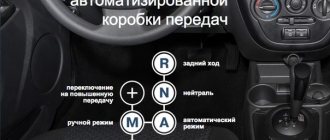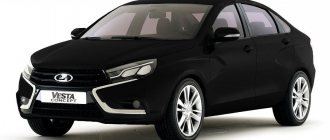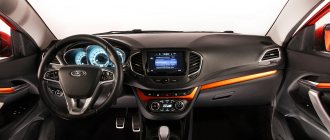How does Vesta SV stand for?
As auto experts explained, the abbreviation in the name of the latest LADA Vesta
SW should be understood as a “Sport Wagon” (sports car), and not a “Station Wagon” (multi-passenger car), as is commonly believed among non-professionals.
Interesting materials:
Swiftkey keyboard how to switch to Russian? Which provider has the best mobile internet? We increase the ringer volume using the engineering menu How is RAM performance measured? What are the advantages of a brushless screwdriver? What is the difference between BMP and JPG? What is the difference between 11 Pro and 12 Pro? What is the difference between CSV and XLS? What is the difference between DVI D Single and DVI D dual? What is the difference between Samsung a51 and a71?
List of sedan characteristics - what you need to know
Lada Vesta is a new car, not the old familiar VAZ, not a copy of Renault, despite the abundance of imported components. Vesta is presented in three versions: Classic, Confort, Luxe. Available with two engines - 21129 and 21179, with two gearboxes - 5MT, 5AMT. At the moment, the sedan is purchased in 16 variants. Vesta received individual characteristics. In all modifications, the Lada is equipped with ABS, airbags, TCS traction control system, HSA hill assist, on-board computer, electric power steering, central locking, heated seats, and daytime running lights. The basic version comes with 185/65R15 tires from Belshina, the luxury version has 195/55R16 tires from Continental. The body is galvanized, the sills and bottom are protected, the ground clearance is high - the car is fully adapted for driving on Russian roads.
Vesta now
Why is the car in demand?
LADA Vesta today is one of the most popular products on the secondary market. It was checked 10,454 times via avtocod.ru last month. Two facts speak in its favor:
- it does not stagnate (average sales time is 10 days, 5-8 days less than Rio and Logan);
it loses moderate value (
And this is obvious, because to the above qualities of Vesta is added its relative problem-free nature. Yes, in 2015 the car came out in a tangible hurry and, of course, a little damp. But the main shortcomings of the Lada Vesta were eliminated in the first year of life on the assembly line, and there were few of them.
The first thing that comes to mind are completely disposable stabilizer struts (links), which in the debut batches of cars were barely enough for a month or two of operation. AvtoVAZ even had to change the supplier, and on later models the suspension stopped knocking immediately after leaving the DC.
What to look for when buying
The new 1.8 engine (122 horsepower) for VAZ caused widespread criticism. Due to the unsuccessful design, there were (and are) problems with low fuel pressure, a bursting expansion tank, and a phase shifter. The manufacturer has recognized some problems and is solving them: they have modified the cylinder head, dealt with the increased pressure of crankcase gases, etc.
So after 2022 you can look at 1.8-liter engines without the same fear, but you need to
should I look at them? No. The difference in dynamics with the 1.6-liter is nominal, but it consumes more fuel, is more expensive to maintain and has reputational problems that will come back to haunt resale.
The AMT “robot” also has a bad reputation, but it’s difficult to find it on the secondary market, because no one needed it even when new. The main problem is increased and fairly rapid wear of the clutch and the 10 thousand rubles of the family budget associated with its replacement. If you start quietly and don’t fire the clutch, it will take longer – like with a conventional manual, 100 thousand+.
Otherwise, some problems with the Lada Vesta are episodic and individual in nature, mainly due to driving style. Even in taxi and other corporate fleets, they travel 200+ thousand kilometers under their own power and without capital investments. Isn’t it an indicator of the strength and endurance of a car?
With what problems is it sold?
The car is relatively new and is often sold as a deposit. After the purchase, at a minimum, spend a lot of time traveling to banks with the previous owner. As a maximum, you can take over someone else's debts if the seller hides the collateral. Therefore, before purchasing, test the car for cleanliness.
Here is a vivid example of a typical “Vesta” from the secondary market: fresh, the mileage is funny, the station wagon is tempting!
We look at the report from avtocod.ru, and everything is bad there, although predictable:
The car is actually in collateral.
Plus, no fines have been paid since June 2020.
There is no particular point in clinging to this option. There are half a million other Wests on the market, among which there is sure to be one good one.
Equipment
For the SV Cross the Luxe package is offered, for the SV - Lux and Comfort. Depending on the configuration, machines can be equipped with the following functions and systems:
- Electronic stability control with traction control option. This helps when starting on a hill.
- Front and front airbags (four in total).
- Three-stage heating of the front and rear seats.
- The driver's seat is height adjustable and has lumbar support.
- Heated windshield and windshield.
- Exterior mirrors are electrically heated and electrically adjustable.
- Automatic climate control system.
- Parktronic.
- Multifunction steering wheel.
- Cruise control system.
- Cooled glove box.
- Audio system.
- Rear armrest.
- Rear View Camera.
- Fog lights.
- Second floor panel.
- Luggage compartment organizer.
- Light and rain sensor.
In addition to the basic package, there are additional packages such as Multimedia, Prestige, Image.
Project development [edit | edit code]
The cost of developing the car was about 6.5 billion rubles. The first body of the pre-production Vesta was welded on November 5, 2014 in Izhevsk. On February 6, 2015, the first LADA Vesta body was welded and painted in Izhevsk using serial technology [4]. On September 25, 2015, a solemn ceremony took place to launch mass production of the model [5].
It was assumed that the sedan would go on sale first on November 25, 2015, then the hatchback [6], but later the plan was changed, and mass production of the station wagon and its off-road version began in 2022.
The Vesta sedan is offered to Russian buyers in three main trim levels. Initially, it was planned that the car would cost about 400 thousand rubles, but then AvtoVAZ President Bo Andersson decided to increase the cost to 500-550 thousand rubles [7]. On November 24, 2015, the final minimum price for the car was announced - 514 thousand rubles. As of December 2016, the price of a car starts from 529 thousand rubles. At the end of November 2022, the price of the car starts from 554,900 rubles.
On August 29, 2016, the head of AvtoVAZ, Nicolas More, said that the company abandoned plans to produce a hatchback due to possible intra-brand competition with the XRAY model [8]. On September 19, 2017, AvtoVAZ began accepting orders for Vesta SW and Vesta SW Cross station wagons.
On January 31, the LADA Vesta Sport appeared with a 1.8 liter engine producing 145 hp. With. This is the first Lada after 1998 worth more than 1 million rubles [ source not specified 90 days
] .
The release of a restyled model, Lada Vesta FL, is planned for the end of 2022 - beginning of 2022. In this configuration, Vesta will receive a completely new front panel, door cards and central floor tunnel. The interior of the car will also undergo changes - a huge multimedia system tablet will appear, with which the air conditioning unit is combined. Innovations will also affect the exterior of the car - new bumpers and radiator grille, plus a different design for the front optics and rear lights.
Specifications [ edit | edit code]
The length of the car exceeds the dimensions of the Priora and is 4.41 m (sedan and station wagon).
The car was created on the Lada B platform, a further processing of the unrealized Lada C project (2006). The design of the car is based on the LADA XRAY concept cars. It is reported that the car received a completely original front suspension with L-shaped arms and new steering knuckles and a 5-degree caster, and steering from Renault Megane. [6] The steering column is adjustable for tilt and reach on all trim levels. Some components, such as the brakes and radiator, are borrowed from Renault-Nissan designs.
The car is equipped with a 1.6 liter VAZ engine (106 hp VAZ-21129) and a 1.8 liter engine (122 hp VAZ-21179). Two transmission options are offered for the car. This is a 5-speed manual transmission and an automated manual transmission (AMT) of Russian design (VAZ 21827) [9]. You can find out which gearbox is on the car by the VIN number of the car: if it has the code GFL13, then the gearbox is Renault, if GFL11, the VAZ “mechanics” VAZ 21807 is installed. Versions with a “robot” have the code GFL12. [10] .
In 2022, LADA Vesta is planned to be equipped with gas-cylinder equipment, which will allow the use of natural gas (methane) compressed to 250 atmospheres as fuel. This version is equally capable of running on both regular gasoline and NG, which significantly expands the capabilities of the car. A pilot batch of gas-powered West and Largus cars of about 300 cars has already been produced (November 2015) and now [ when?
] is undergoing certification [11] .
Answers (1)
The Lada Vesta car belongs to the B-class, which includes cars such as Chevrolet Aveo, Citroen C-Elysee, Ford Fiesta Sedan, Hyundai Solaris, KIA Rio, Nissan Almera, Peugeot 301, Renault Logan, Volkswagen Polo Sedan, Ravon Nexia R3 . However, Vesta in its class is a little wider and longer than many competitors and falls a little short of the C-class, where there are already such cars as Kia Sid, Chevrolet Cruze, Golf, Octavia.
This car can be classified as class B+, and in terms of price orientation - in the budget segment very close to the middle class.











